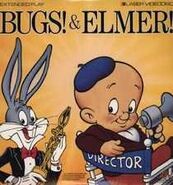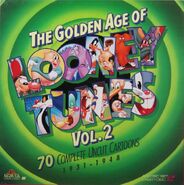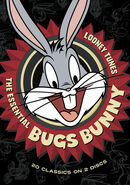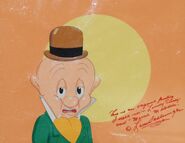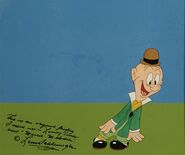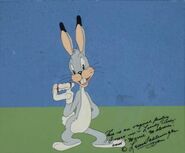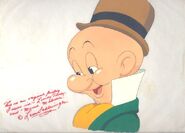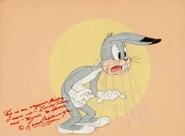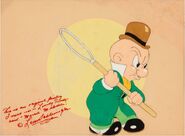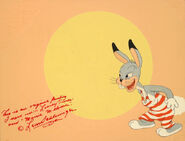Elmer's Candid Camera is a 1940 Merrie Melodies short directed by Charles Jones.
Plot[]
Elmer Fudd wants to learn how to take photos of wildlife and grabs his camera kit to begin his progress. Elmer tries to photograph rabbits after seeing footprints, which leads to a mischievous gray rabbit. Elmer tries to hide behind the rabbit to take a picture of him, but the rabbit sneaks behind and asks to have a look. When Elmer finds out the rabbit has moved, the rabbit starts to leave.
Elmer decides to take a picture of a squirrel instead, but the rabbit returns to continuously bother Elmer. He grabs the lens of the camera and springs it back onto Elmer, launching him back into an apple tree. The rabbit throws an apple core at the tree to knock an apple down on Elmer. Elmer attempts to photograph a bird, but the rabbit taunts him again, and an angered Elmer now wants to forget photographing in the meantime to capture the rabbit. The rabbit tries to fake himself suffering, and Elmer falls for the ploy to release him, causing the rabbit to place Elmer in the net and make his escape.
Elmer is now driven insane, destroys his camera set, and jumps into a lake. He nearly drowns, while the rabbit swims to rescue Elmer. After ensuring Elmer is fine, the rabbit boots Elmer back into the lake and tosses the photographing book at Elmer's face for further insult.
Availability[]
Elmer!
Cartoon Moviestars: Elmer!
Cartoon Moviestars: Bugs! and Elmer!
The Golden Age of Looney Tunes, Vol. 2, Side 2: Early Wabbits
Looney Tunes: The Collectors Edition, Vol. 11: Wabbit Tales (1995 USA Turner dubbed version)
Looney Tunes Golden Collection: Volume 1, Disc Three (restored with DVNR)
Looney Tunes Spotlight Collection: Volume 1, Disc 1 (restored with DVNR)
Looney Tunes Collection All Stars Volume 1
Looney Tunes Collection All Stars Volumes 1 & 2, Disc 1
The Essential Bugs Bunny, Disc 1 (restored with DVNR)
3 Spooky DVD Treats
Looney Tunes Platinum Collection: Volume 2, Disc Two (restored without DVNR)
Looney Tunes Platinum Collection: Volume 2, Disc Two (restored without DVNR)
Looney Tunes Center Stage Volume 1
Looney Tunes Center Stage
Looney Tunes Triple Feature
Looney Tunes Spotlight Collection Volumes 1-3 Repack
Bugs Bunny 80th Anniversary Collection, Disc 1 (restored without DVNR)
Streaming[]
Notes[]
- In this cartoon, Elmer Fudd was given a new redesign and he still wears the same derby hat, high collar, and green coat that has been wearing when he first debuted in Tex Avery's "Little Red Walking Hood" (1937), and has a large, bulbous nose, which was not pink in this cartoon, But he reappears in "A Wild Hare" (1939) and "Wabbit Twouble" (1941) with a pinkish noes again. This is Elmer Fudd's ninth appearance. This is also the first time Arthur Q. Bryan voices him in his "milk-sop" and "hewwo" voice that he used earlier in a Merrie Melodies cartoon titled "Dangerous Dan McFoo" (1939) directed by Tex Avery. And in this cartoon the fourth appearance, and then a cameo in Robert "Bob"" Clampett and Warren Foster's "Patient Porky", of Ben Hardaway's rabbit, who would become Bugs Bunny a few months later, beginning with "A Wild Hare".
- The Prototype-Bugs Rabbit from the three earlier cartoons is more like Bugs Bunny in this short, except he has apricot-colored hands and mouth, furrier tail, black nose, black-tipped ears, and a different voice. The rabbit's voice sounds "rural", and at times sounds rather like Daffy Duck's early voice. The laugh at the end of the cartoon, "Heh-heh-heh-HEH-heh!", is similar to that of another Blanc character, the early version of Woody Woodpecker, which would debut later in the year.
- Elmer's voice is fully developed, and his appearance is similar to that in later cartoons, except for having shiny cheeks and nose. When in a mild-mannered mood, he is very much like the familiar Elmer. When enraged, his appearance is decidedly uncharacteristic, nearly maniacal.
- Chuck Jones was extremely critical of this short, as he says in his book Chuck Amuck. "Perhaps the kindest thing to say about 'Elmer's Candid Camera' is that it taught everyone what not to do and how not to do it" is one of the things he says about the short.[4]
Gallery[]
References[]
- ↑ Catalog of Copyright Entries
- ↑ (3 October 2022) Cartoon Voices of the Golden Age, Vol. 2. BearManor Media, page 79.
- ↑ Jones, Chuck (1989). "The Writers: The Slum Kid, the Scion, and Me", Chuck Amuck: The Life and Times of an Animated Cartoonist. Farrar Straus Giroux, page 114. ISBN 978-0374123482.
- ↑ Jones 1989, p. 197



